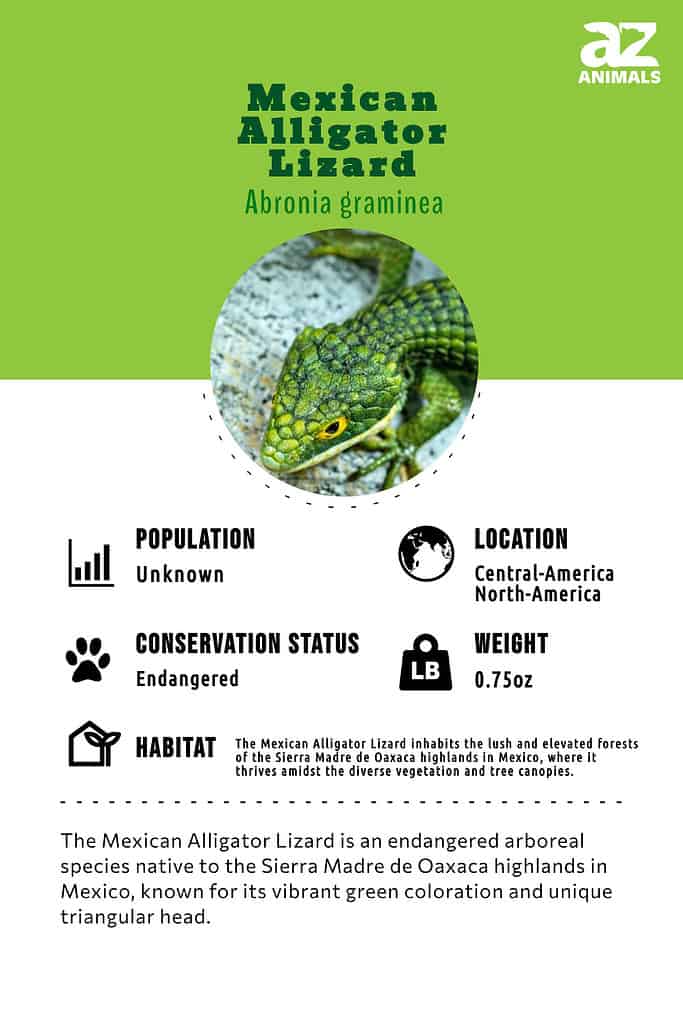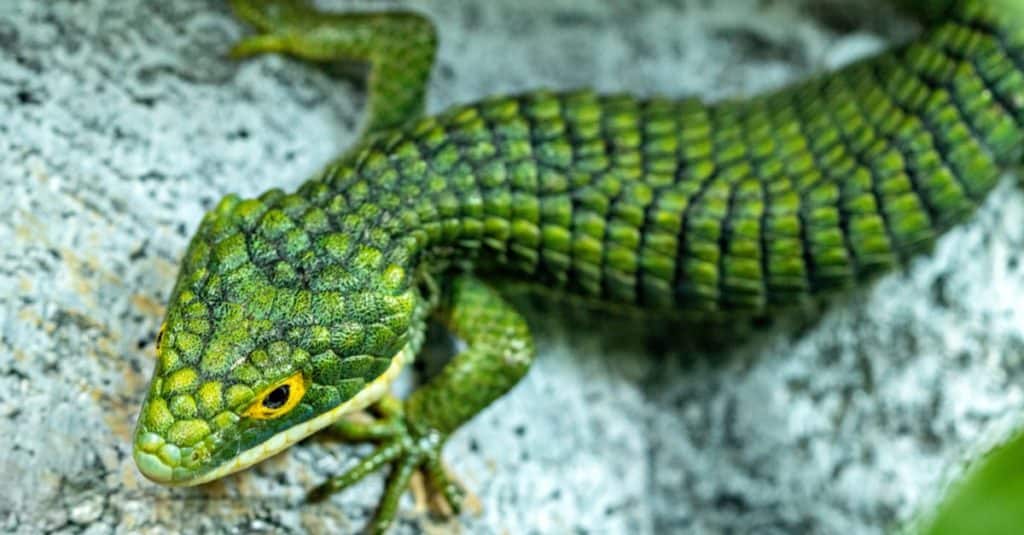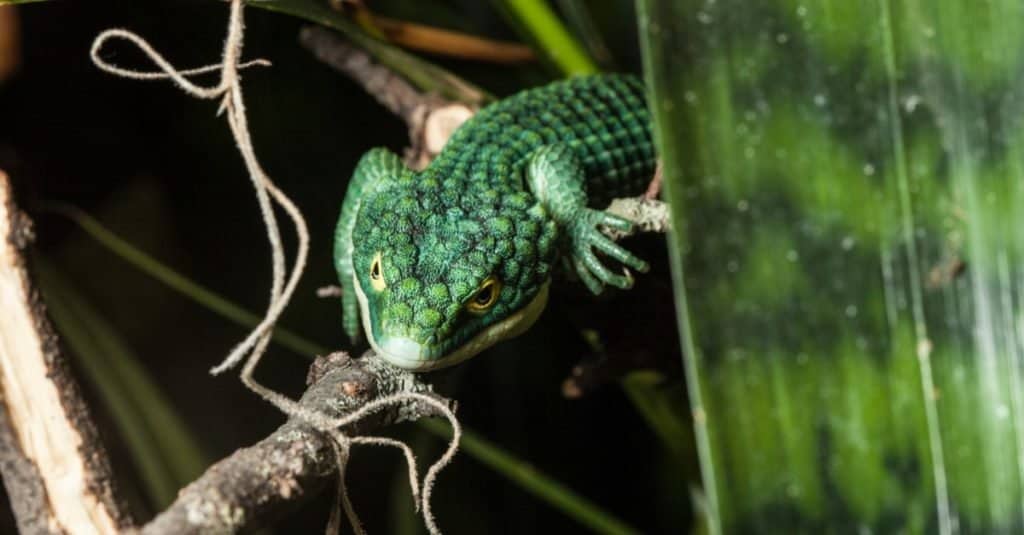Mexican Alligator Lizard
Abronia graminea
Mexican alligator lizards shed their skin like snakes.
Advertisement
Mexican Alligator Lizard Scientific Classification
- Kingdom
- Animalia
- Phylum
- Chordata
- Class
- Reptilia
- Order
- Squamata
- Family
- Anguidae
- Genus
- Abronia
- Scientific Name
- Abronia graminea
Read our Complete Guide to Classification of Animals.
Mexican Alligator Lizard Conservation Status
Mexican Alligator Lizard Facts
- Prey
- Diurnal crickets, grasshoppers, hornworms
- Name Of Young
- Neonates
- Group Behavior
- Solitary
- Fun Fact
- Mexican alligator lizards shed their skin like snakes.
- Estimated Population Size
- Unknown
- Biggest Threat
- Man
- Most Distinctive Feature
- Vibrant color
- Other Name(s)
- Green arboreal alligator lizard
- Gestation Period
- 6-8 months
- Litter Size
- 1-12
- Habitat
- Mesic cloud and pine-oak forest canopies
- Predators
- Dogs, cats, rodents
- Diet
- Carnivore
- Type
- Reptile
- Common Name
- Alligator lizard, green arboreal alligator
- Number Of Species
- 1
- Location
- Mexico
View all of the Mexican Alligator Lizard images!

The Mexican alligator lizard lives about 130 feet in the air in Mexico’s cloud forests.
This bright green lizard is listed as endangered as man destroys its habitat for agricultural purposes.
There has been very little study of this lizard in the wild, but it lives for about 10 years in captivity.
5 Incredible Mexican Alligator Lizard Facts!

The extinction of this lizard is being driven by the illegal hunting of its species and the encroachment upon additional agricultural territory.
©Wesley Aston/Shutterstock.com
- Mexican alligator lizards live in trees in Mexico’s cloud forests.
- Illegal poaching and claiming more agricultural land are causing this lizard to go extinct.
- Mexican alligator lizards live for about 10 years.
- Mexican alligator lizards eat insects.
- Mexican alligator lizards are usually bright green.
Scientific Name
The scientific name of Mexican alligator lizards is Abronia graminea. They are members of the Reptilia class, which also includes turtles and snakes. They are members of the Squamata order, the Anguidae family, and the Abronia genus.
There are 67 species of alligator lizards in the world. Eight of them live in North America.
Evolution and Origins
The alligator lizard possesses a triangular-shaped head and a flexible tail that aids in climbing and maneuvering within the upper branches of trees. With a maximum length reaching approximately 9.8 inches (25 centimeters), this species is indigenous to the Mexican regions of Veracruz and Pueblo.
The endangered Mexican alligator lizard (Abronia graminea), also referred to as the green arboreal alligator lizard, is a lizard species exclusive to the elevated Sierra Madre de Oaxaca region in Mexico.
Further, the alligator lizard attains maturity in approximately 18 months and has a lifespan that can extend up to 15 years.
Appearance

Fully grown lizards display a vivid green hue, reminiscent of the fresh spring foliage, accompanied by a distinctive yellow ring encircling their eyes.
©K Hanley CHDPhoto/Shutterstock.com
Adult lizards are a vibrant green. Their color is similar to the color of leaves in the spring. They have a bright yellow circle around their eyes.
The facts are that the male is much more colorful than the female, which is a much deeper color, and the circle around the eye is much more subtle.
Juvenile lizards are born a tannish color with subtle black dots. This coloring provides camouflage so that predators do not as easily spot them.
Each has very defined scales, adding to its beauty. The scales usually are a green color with some black lines and dots in them.
When kept in captivity, many of these lizards lose their vibrant green colors. Instead, they turn teal colors. Scientists are not sure why they change colors, but they think this is because of the difference in light. They need the sun to retain their original color.
All of these endangered lizards have triangular-shaped heads. The head has very sharp teeth, which helps them eat hard-shelled insects. They also have a long tail that can be up to 50% as long as their body. If they get into trouble, they can release their tail to get away from danger or predators.
These alligator lizards have short legs with long claws. They can use their sharp claws to hold on better in the trees where they live.
Behaviors
These lizards live in trees in cloud forests. They spend most of their day among tropical plants. The Mexican alligator lizard prefers to live near bromeliads because the cup-like leaves capture water for these lizards to drink.
They are most active during the day and sleep at night. These alligator lizards spend a lot of their time catching insects to eat.
Habitat

These lizards inhabit the trees of Mexico’s cloud forest, with only a sparse population also existing in Guatemala. They exhibit a preference for residing approximately 130 feet above the forest floor.
©Wesley Aston/Shutterstock.com
These lizards live in trees in Mexico’s cloud forest. Very few are also found in Guatemala. They prefer to live about 130 feet above the ground.
The cloud forests of Mexico are shrinking as more land is converted for agricultural purposes. These areas contain young trees that tie together areas of old-growth forests.
If you choose to raise these alligator lizards in captivity, you need to provide for their needs. They need to be in a terrarium with lots of humidity.
Be sure that they have light during the day and darkness at night. You need to provide lots of places for them to climb and hide. They can withstand temperatures as low as 40 degrees Fahrenheit.
Diet
These lizards eat insects. They are opportunistic eaters in that they eat whatever insects are available. Sharp teeth allow them to crack the shells of even the toughest insect.
If you keep one of these lizards in captivity, feed them three to four crickets, moths, wax worms, small cockroaches, hornworms, mealworms, stick insects, or flies per lizard weekly.
Female lizards stop eating about a month before they give birth. As soon as they give birth, they will return to eating.
Reproduction and Life Cycle
Females usually become sexually mature during their third year. These lizards give birth to one to 12 juveniles.
Usually, breeding occurs in the late summer or early fall. Then, the babies are born from late April to late July. In captivity, females will stop eating for about a month before giving birth, but few studies have been done on their mating and breeding behaviors in their native habitat.
Scientists know that other species of alligator lizards do not practice elaborate mating rituals. Instead, males seek out females interested in breeding, and the sexual act occurs.
Population
The IUCN lists the lizard on its endangered species list. They say that the population is decreasing. No one knows for sure exactly how many are left in the wild.
View all 164 animals that start with MMexican Alligator Lizard FAQs (Frequently Asked Questions)
Are Mexican Alligator Lizards Good Pets?
Intermediate and expert lizard raisers often enjoy raising Mexican alligator lizards. Be aware that these lizards can be aggressive. While not venomous, they can bite and remove pieces of your skin if you are bitten. Staff working with these lizards in zoos say that the bites are some of the most painful they experience.
If you are thinking of getting one as a pet, consider those bred in captivity. You may want to think again because this lizard bites. Besides the bites, the population in the wild is decreasing. Poachers often pay children $1 or $2 to capture the animals. Then, they are snuck across the border into the United States.
Can You Buy a Mexican Alligator Lizard?
Yes, you can buy a Mexican alligator lizard. A male and female pair costs about $350. Make sure you are dealing with a reputable breeder who only sells lizards raised in captivity. Before getting one, think about the care that they need. Part of that care is to create a humid terrarium with many hiding spots where they can live. Another aspect of their care is being prepared to feed them insects regularly. Finally, you need to think about how you will provide the right temperature for their care.
How big Does a Mexican Alligator Lizard Get?
Mexican alligator lizards grow to be about 9 inches long. About 33% of this length is their tail.
Why Is the Mexican Alligator Lizard Endangered?
There are at least two reasons why Mexican alligator lizards are endangered. Many are caught and sold to people who smuggle them into the United States as part of illegal pet trading. This is harmful to the environment because it upsets the delicate biosystem and can have long-lasting consequences.
Furthermore, these lizards are endangered by the loss of their habitat. Scientists estimate that each year, the amount of cloud forest in Mexico shrinks by 1.1%. In addition to Mexican alligator lizards, these young forests are essential to pollinators. Upsetting the balance may be the end of many animals, including the Mexican alligator lizard.
Thank you for reading! Have some feedback for us? Contact the AZ Animals editorial team.
Sources
- Smithsonian's National Zoo & Conservation Biology Institute / Accessed June 21, 2021
- Reptile Direct / Accessed June 21, 2021
- Animal Diversity Web / Accessed June 21, 2021
- Herp Care Collection / Accessed June 21, 2021
- Good Life Herps / Accessed June 21, 2021
- Berkshire Museum / Accessed June 21, 2021
- Backwater Reptiles / Accessed June 21, 2021


















